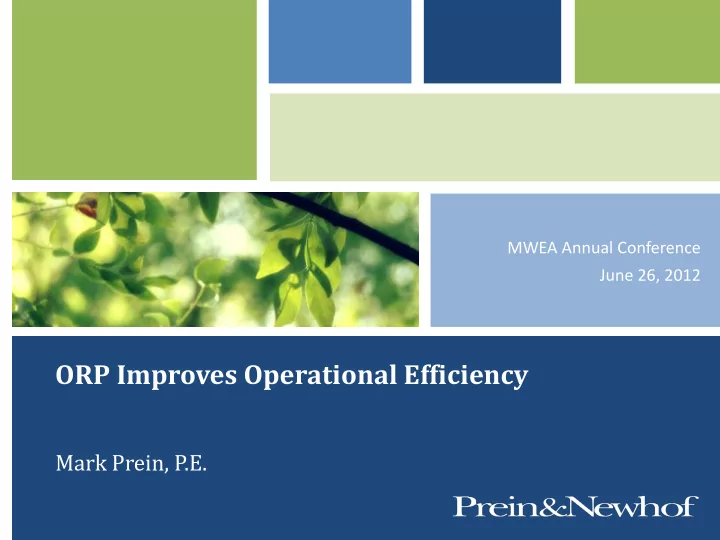

MWEA Annual Conference June 26, 2012 ORP Improves Operational Efficiency Mark Prein, P.E.
What is ORP
ORP Definition Oxidation What Reduction Is ORP? Potential
ORP Definition Bing says 8,650,000 definitions 1. A chemical reaction in which oxygen is added to an element or compound 2. The process of losing electrons from a OXIDATION chemical element or compound (CHEMICAL) Example: Nitrification + + 3O 2 -> 2H + + 2H 2 O + 2NO 2 - 2NH 4 - + O 2 -> 2NO 3 - 2NO 2
ORP Definition Bing says 50,300,000 definitions Any chemical reaction in which the atoms in a material take on electrons. Note: Reduction is the opposite of oxidation. REDUCTION (CHEMICAL) Example: Denitrification - + organic matter -> N 2 (Gas) + CO 2 + H 2 O 2NO 3
ORP Definition Bing says 204,000,000 definitions 1.Possible but as yet not actual: having a latent possibility or likelihood of occurring, or of doing or becoming something POTENTIAL 2.Capacity for development: a capacity to develop, succeed, or become something How steep is the hill you are standing on?
ORP Definition In wastewater treatment, ORP is: A measure of the ability or potential of a wastewater to permit specific biological reactions (oxidation and or reduction).
ORP Biological Values Biochemical Reactions and Corresponding ORP Values Biochemical Reaction ORP, mV Nitrification +100 to +350 cBOD degradation with free molecular oxygen +50 to +250 YSI Environmental Biological phosphorus removal +25 to +250 – Application Note Denitrification +50 to -50 Sulfide (H2S) formation -50 to -250 Biological phosphorus release -100 to -250 Acid formation (fermentation) -100 to -225 Methane production -175 to -400
ORP Equipment
Where Might You Use ORP • Collection System • Lift Stations • Sewers • Treatment Plant • Activated Sludge • Anaerobic • Anoxic • Aerobic • Digesters • Fermenters • Final Clarifiers
How Use ORP • Collection System • Hydrogen Sulfide Control • Treatment Plant • CBOD removal • Nitrification • Denitrification • Biological Phosphorous Removal • Fermentation • Methane production
ORP Biological Values Biochemical Reactions and Corresponding ORP Values Biochemical Reaction ORP, mV Nitrification +100 to +350 cBOD degradation with free molecular oxygen +50 to +250 YSI Environmental Biological phosphorus removal +25 to +250 – Application Note Denitrification +50 to -50 Sulfide (H2S) formation -50 to -250 Biological phosphorus release -100 to -250 Acid formation (fermentation) -100 to -225 Methane production -175 to -400
Placement ORP Probe • Understand the process • Location is Critical • Avoid influence of process equipment • Be aware of process phases • Maintenance required
Examples
Please: Ask Questions As We Go
Collection System Large Community Random Odor complaints • Could not be tied to operational changes • Could not be tied to wet/dry weather events Sewer Collapse in Area Have high H 2 S levels but why?
Collection System OdaLogger Red Arrow Odalogger Results
Collection System Units 8/28/2010 8/29/2010 8/30/2010 Lab BOD 5 mg/l 380 89 285 Sulfate mg/l 4.21 21.7 10.6 Total Sulfide mg/l 5.4 3 3.9 TSS mg/l 568 46 307 Sample Field pH s.u. 7.75 7.63 7.99 Event Temp °C 21 22.95 25.02 Results D.O. mg/l 3.93 2.62 3.01 Dis Sulfide mg/l 4.55 5.35 3.25 H 2 S, Air ppm 37 66 27 % O 2 % 20.9 20.9 20.9 LEL s.u. 0 0 0
Collection System Units 8/28/2010 8/29/2010 8/30/2010 Lab BOD 5 mg/l 380 89 285 Sulfate mg/l 4.21 21.7 10.6 Total Sulfide mg/l 5.4 3 3.9 The TSS mg/l 568 46 307 Field Rest pH s.u. 7.75 7.63 7.99 Of Temp °C 21 22.95 25.02 D.O. mg/l 3.93 2.62 3.01 The Story Dis Sulfide mg/l 4.55 5.35 3.25 H 2 S, Air ppm 37 66 27 % O 2 % 20.9 20.9 20.9 LEL s.u. 0 0 0 ORP mv -68.6 -89.3 -61.4
ORP Conversion Re-aeration Example
WWTP Upset Treatment and Odor Event
WWTP Upset Background • Plant 1. Aerated Lagoon System 2. Settling Ponds 3. Storage Ponds • Operations 1. Monitor Influent and Effluent for standard parameters 2. DO measured at effluent 3. As Effluent DO varies, adjust air feeds • Event 1. Over very short period went anaerobic 2. With all aeration on, could not meet demand
WWTP Upset - Investigation Effluent Dissolved Oxygen vs. Aerators 7.0 14 6.0 12 5.0 10 Number of Aerators Average DO, mg/l 4.0 8 3.0 6 hjg 2.0 4 Aerators 1.0 2 0.0 0 Date
WWTP Upset - Investigation Mixers turned off to save energy • when DO demand low When mixers turned on: • 1. Re-suspend solids 2. Initial increase in DO demand 3. Some Odor During spring warm-up • 1. Increasing biological activity 2. Influent Loading 3. Stored Loading Mixer selection based on effluent • DO, which indicated wastewater carrying a positive DO
WWTP Upset Background DO Temperature hjg
WWTP Upset Background Aerators vs. Temperture 16 24 14 21 12 18 Temperature 10 15 Temperature, Degree C Aerators 8 12 6 9 Aerators 4 6 2 3 0 0 Date
WWTP Upset Background DO vs. ORP Results 8.0 150 7.0 100 6.0 50 5.0 0 DO, mg/l ORP, mv 4.0 -50 3.0 -100 hjg 2.0 -150 1.0 -200 0.0 -250 Date
WWTP Upset - Findings Operator placed in a no win • situation by positive DO probe results Actual events • 1. Spring with warm temperatures 2. Entire volume went anaerobic 3. Turned on mixers for more air, which in turn added more demand DO probe under influence of • point of re-aeration Mixers must be turned on • before demand
Aerobic Digestion/Holding Biosolids Holding Tank
Aerobic Digestion/Holding • Holds Activated Sludge • Fully Automated Controls 1. Level Sensor 2. DO Sensor 3. ORP Sensor • Process Operations Fill – Selected Tank • Mix/Aerate • Settle/Decant • Feed ISPs •
SCADA CONTROL
Typical Operation
A Little Easier to Read
What Is Really Happening? 2 Energy Savings 1
Its Only A Tool 1 - Air Off, Start Press 3-Decant 2-Settled
Thank You
Recommend
More recommend